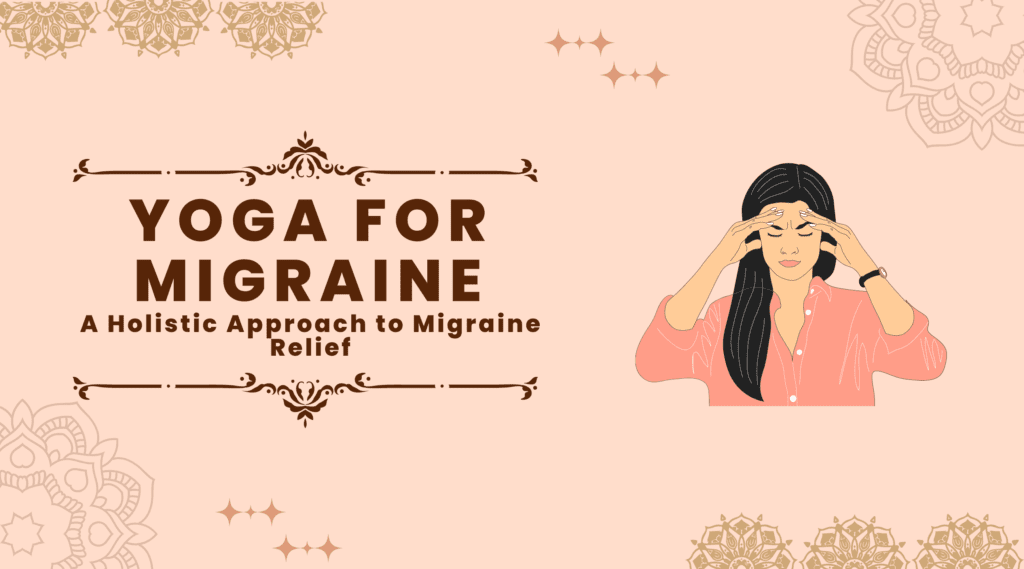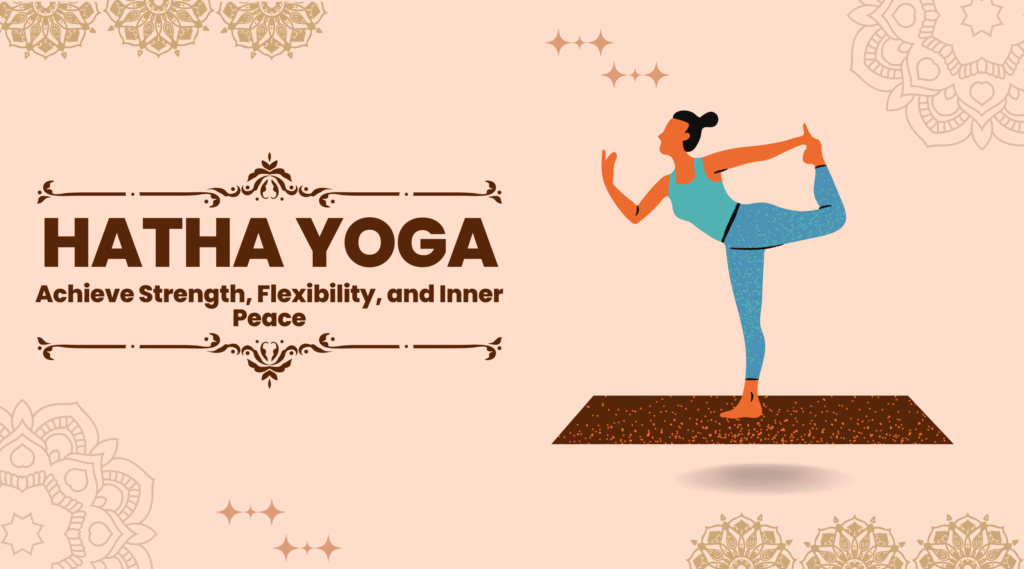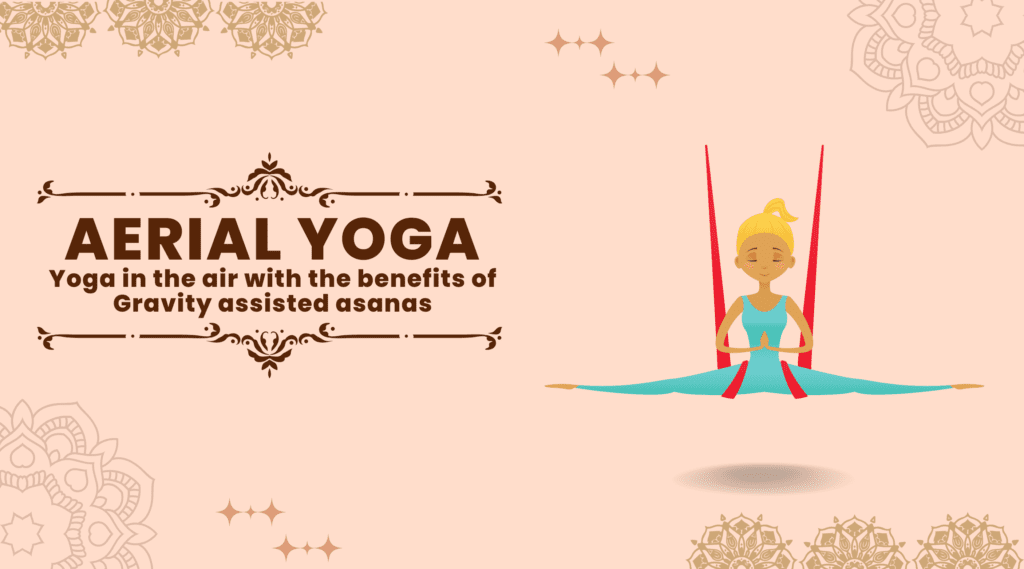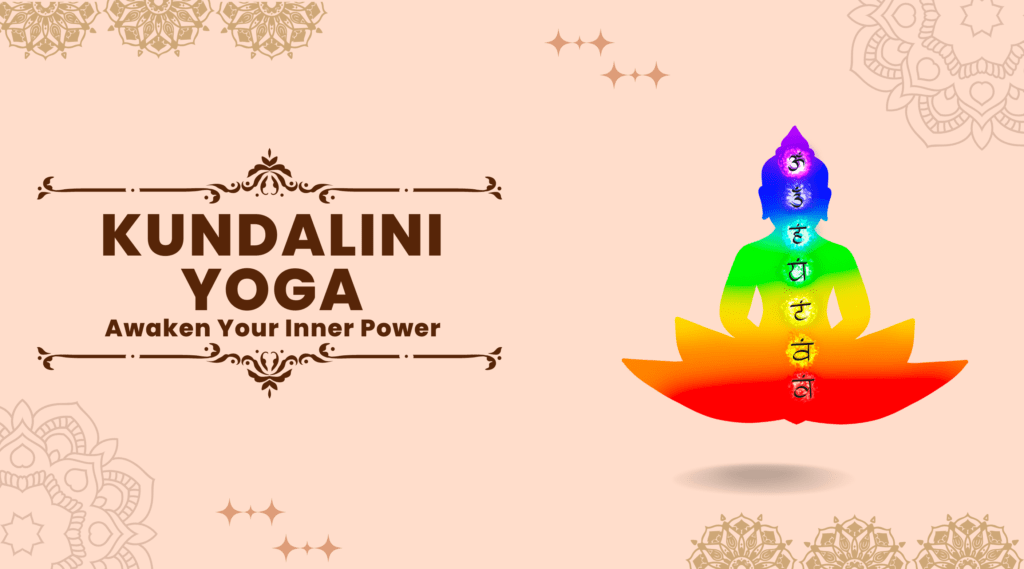Migraine: Embrace Yoga as a Holistic Approach to Migraine Relief

Introduction
What is Migraine?
Migraine is a kind of neurological disorder. Millions of people are suffering from worldwide from this problem. In the condition of migraine, there is a recurring headache. This headache can be moderate to severe, and often accompanied by symptoms such as nausea, vomiting, and sensitivity to light and sound.
The headache can occur on one side of the head or on both sides. When there is a right side headache or left side headache, it is called a unilateral headache. And when it is on both sides of the head, it is called a bilateral headache.
This pain can be quite debilitating and badly impact one’s quality of life. In this article, we will explore the different types of migraines. We will also discuss its causes as well as how to incorporate Yoga for Migraine.
Suggested: Best Yoga Retreats And Yoga Teacher Training In Rishikesh
Types of Migraines
There are several types of migraines, each with its own unique set of symptoms and triggers. However, the most common types are as following:
1. Migraine without aura:
This is the the most common type of migraine, in this type of migraine, headache is moderate to severe that lasts for several hours to days. People suffering from this type of migraine may experience nausea, vomiting, and sensitivity to light and sound.
2. Migraine with aura:
This type of migraine is characterised by visual disturbances such as flashing lights, zigzag lines, or blind spots, which can occur before or during the headache. Other aura symptoms may include tingling or numbness in the face or hands and difficulty speaking.
3. Chronic migraine:
This type of migraine occurs when a person experiences migraines for 15 or more days per month. People with chronic migraines may have a headache on most days, and the pain may be less severe than in other types of migraines.
4. Menstrual migraine:
This type of migraine is generally triggered by hormonal changes during the menstrual cycle and often occurs just before or during menstruation. Women who experience menstrual migraines may also have other menstrual-related symptoms such as cramping and bloating.
5. Vestibular migraine:
This migraine type generally involves dizziness, vertigo as well as balance problems in addition to headache pain. People with vestibular migraines may also experience nausea, vomiting, and sensitivity to light and sound.
6. Hemiplegic migraine:
This type of migraine is rare and can cause temporary paralysis or weakness on one side of the body. Hemiplegic migraines may also cause other symptoms such as vision changes, difficulty speaking, and confusion.
7. Retinal migraine:
This type of migraine is rare and affects vision in one eye. People with retinal migraines may experience temporary blindness or loss of vision in one eye, in addition to headache pain.
8. Abdominal migraine:
This is a type of migraine headache that primarily affects children. It is characterised by recurrent episodes of abdominal pain that usually last for several hours. The pain is often severe and can be accompanied by other symptoms such as nausea, vomiting, and diarrhoea.
9. Basilar Migraine:
It is also known as migraine with brainstem aura (MBA), is a type of migraine headache that involves aura symptoms originating from the brainstem. The brainstem is the area of the brain that controls many important bodily functions, such as breathing, heart rate, and blood pressure.
10. Cluster Migraines:
this migraine type is sometimes referred to as “cluster headaches”. It is a type of headache that occur in cycles or clusters. They are characterised by intense, excruciating pain on one side of the head, typically around the eye or temple. Cluster headaches can occur several times a day, often at the same time each day, and can last from 15 minutes to several hours.
Symptoms of Migraines
Migraines symptoms may vary from person to person, but they generally include:
1. Headache: Migraine headaches are typically characterised by a throbbing or pulsating pain that can be moderate to severe in intensity. The pain often occurs on one side of the head but can occur on both sides.
2. Aura: Many people with migraines experience an aura before the onset of the headache. The aura can include visual disturbances such as seeing flashing lights or zigzag lines, or sensory changes such as numbness or tingling in the face or limbs.
3. Nausea and vomiting: Many people with migraines experience nausea and vomiting, which can worsen the headache pain.
4. Sensitivity to light and sound: People with migraines may be sensitive to light and sound and may need to seek out a dark, quiet environment to find relief.
5. Fatigue: Migraines can be very exhausting, and people may feel very tired or fatigued after an attack.
6. Dizziness or vertigo: Some people with migraines may experience dizziness or vertigo, which can make it difficult to perform daily activities.
What Causes Migraines
The actual cause of migraines is not completely known. However there is a belief that it is a combination of genetic and environmental factors. These factors affect the brain and its blood vessels. Let’s take a look on some general causes of migraines:
1. Genetics: Migraines tend to run in families, suggesting that there may be a genetic component involved. Certain genes have been identified that are associated with an increased risk of migraines.
2. Hormones: Migraines are more common in women than men, and they often occur around the time of menstruation. Fluctuations in hormones, such as estrogen and progesterone, may play a role in triggering migraines.
3. Migraine Triggers: Certain foods, drinks, and environmental factors can trigger migraines in some people. Common triggers include alcohol, caffeine, chocolate, cheese, stress, lack of sleep, and changes in weather.
4. Abnormalities in the brain and its blood vessels: Migraines are thought to involve changes in the brain and its blood vessels. During a migraine attack, the blood vessels in the brain may constrict and then dilate, causing pain and other symptoms.
5. Neurotransmitters: Migraines may be related to abnormalities in the levels of certain neurotransmitters in the brain, such as serotonin and dopamine.
How Yoga Can Help with Migraines
Yoga can be a natural and effective way to manage migraines and reduce their frequency and intensity. The practice of yoga can help with migraines in several ways such as:
1. Reducing Stress: Stress is one of the primary triggers of migraines. Yoga can help reduce stress levels by calming the nervous system, which in turn can help prevent migraines.
2. Improving Blood Circulation: Yoga poses can increase blood flow and oxygen to the brain, which can help alleviate migraines.
3. Relaxing the Body and Mind: Yoga helps release tension in the body and calm the mind. This way it helps reduce the intensity and frequency of migraines.
Yoga Poses for Migraines
1. Downward-Facing Dog Pose (Adho Mukha Svanasana):
This pose stretches the spine, shoulders, and neck. Hence it can help release tension and relieve migraines.
2. Child’s Pose (Balasana):
This pose helps calm the mind and reduce stress levels. It also gently stretches the back and neck, which can help relieve migraines.
3. Standing Forward Fold (Uttanasana):
This pose can help relieve tension in the neck and shoulders. It also increases blood flow to the head, which can help alleviate migraines.
4. Eagle Pose (Garudasana):
This pose helps release tension in the shoulders and upper back, which can help alleviate migraines.
5. Seated Forward Bend (Paschimottanasana):
This pose can help calm the mind and reduce stress levels. It also stretches the back and neck, which can help relieve migraines.
6. Fish Pose (Matsyasana):
This pose can help relieve tension in the neck and shoulders. It also increases blood flow to the head, which can help alleviate migraines.
7. Corpse Pose (Savasana):
This pose is a relaxation pose that can help calm the mind and reduce stress levels. It is a great way to end a yoga practice and reduce the likelihood of a migraine.
8. Supported Shoulderstand (Salamba Sarvangasana):
Lie on your back with your legs raised up and supported by a wall or other prop. This pose can help improve circulation to the head and calm the mind.
9. Legs Up the Wall Pose (Viparita Karani):
Lay down on your back and keep your legs resting up against a wall. This pose helps improve circulation to the head and relieve tension in the neck and shoulders.
10. Head-to-Knee Forward Bend (Janu Sirsasana):
Sit with one leg stretched out in front of you and the other leg bent with the foot touching the inner thigh. Fold forward over the outstretched leg and reach for your toes. This pose can help relieve tension in the neck and shoulders and improve circulation to the head.
11. Cat-Cow Stretch (Marjaryasana-Bitilasana):
Start on your hands and knees, then alternate between arching your back and rounding it. This pose can help release tension in the neck and spine.
These are the yogasan for migraine, which are very helpful in managing the problem of migraines.
Pranayama for Migraines
Apart from incorporating yoga for migraines, it is more beneficial if we use pranayama for migraines also. Pranayama, which refers to the practice of controlling the breath in yoga, can be beneficial for managing migraines in several ways such as:
1. Stress reduction: Pranayama practices, such as alternate nostril breathing (Nadi shodhana) and deep belly breathing (diaphragmatic breathing), can help reduce stress and tension in the body, which are common triggers of migraines.
2. Oxygenation: Certain pranayama practices, such as Kapalabhati (skull-shining breath) and Bhastrika (bellows breath), can help increase oxygen flow to the brain and improve blood circulation, which can reduce the frequency and intensity of migraines.
3. Relaxation response: Pranayama practices can activate the relaxation response in the body, which can help reduce pain and tension associated with migraines.
4. Hormonal balance: Some research suggests that regular pranayama practice can help regulate hormones, which may be a contributing factor to migraines in some individuals.
Here are the main pranayamas which are especially helpful in the condition of migraines:
1. Anulom Vilom
Anulom Vilom pranayama also known as alternate nostril breathing, Nadi Shodhana pranayama or “the breath of purification”. This pranayama is commonly practised to promote balance and relaxation in the body and mind.
This pranayama technique involves inhaling and exhaling through alternate nostrils while holding one nostril closed with the fingers. It can help calm the mind, reduce stress, and improve circulation, which can help reduce the frequency and intensity of migraines.
To do Anulom Vilom, you need to sit in a comfortable position while keeping your back straight and shoulders relaxed. Now using your right hand, place your thumb on your right nostril and your ring and little fingers on your left nostril.
Now slowly take a long deep breath through your left nostril while closing your right nostril with your thumb. Hold the breath for a while, then remove your thumb and exhale through your right nostril while closing your left nostril with your ring and little fingers.
Do the same practice with the right nostril also. Repeat this pattern for several rounds, alternating the nostrils with each inhalation and exhalation.
2. Bhramari Pranayama
Bhramari (Humming Bee breath): This pranayama technique involves inhaling deeply and exhaling while making a humming sound like a bee. It can help reduce stress and tension in the body and activate the relaxation response, which can reduce pain and tension associated with migraines.
To practise Bhramari pranayama for migraines, Sit comfortably keeping back straight and shoulders relaxed.Now close eyes and place your index fingers on your ears, and your thumbs on your forehead.
Take a deep breath in through your nose, hold it for sometime and as you exhale, make a low humming sound like the buzzing of a bee, while pressing your forehead with your thumbs and keeping your mouth closed.
Focus on the vibration and sound of the humming. Keep repeating this process for as many times as you feel comfortable.
3. Ujjayi Pranayama
Ujjayi (Victorious breath): is also known as “victorious breath” or “ocean breath” due to the sound it produces, which is similar to the sound of waves in the ocean.
This pranayama technique involves inhaling and exhaling through the nose while slightly constricting the back of the throat. It can help reduce stress and tension and improve circulation, which can reduce the frequency and intensity of migraines.
To practise Ujjayi pranayama, sit in a comfortable seated position while having your back straight and shoulders relaxed. Now constrict your throat and inhale through your nose while expanding your chest and filling your lungs with air.
Exhale through your mouth while slightly constricting your throat muscles, creating a hissing or ocean-like sound. Focus on the sound and sensation of your breath as you continue to practise Ujjayi pranayama. Do it for as many rounds as you feel comfortable.
4. Udgeeth pranayama
It is a pranayama technique in which the breath is exhaled slowly while chanting the sound “Om” or “Aum”. It is also known as Om chanting pranayama. Udgeeth pranayama is believed to have several benefits, including reducing stress and anxiety, improving concentration and focus, thus offering a good help in managing migraines.
To practise Udgeeth pranayama, get into a seated position with your back straight and shoulders relaxed. Inhale long and deep and exhale slowly while chanting the sound “Om” or “Aum” for the entire duration of the exhalation.
Focus on the sound and vibration of the “Om” as you chant it. This is one round, but you need to repeat this process for multiple rounds according to your capability.
5. Bhastrika pranayama
Bhastrika pranayama is a type of pranayama technique in yoga that involves forceful and rapid breathing through the nose. It is also known as “bellows breath” due to the rapid and vigorous movement of the diaphragm during the practice.
It is helpful in reducing migraines due to its ability to promote relaxation, reduce stress, and improve circulation in the body.
Migraines are often triggered by stress and tension in the body, and Bhastrika pranayama can help to release this tension by calming the mind and nervous system. This, in turn, can help to alleviate the symptoms of migraines.
Additionally, Bhastrika pranayama improves circulation by increasing the oxygen supply to the brain and other parts of the body. This can help to reduce inflammation and promote healing, which can be beneficial for those who suffer from migraines.
To practise Bhastrika pranayama, get in a seated position keeping back straight and shoulders relaxed. Begin inhaling and exhaling rapidly through your nose, with forceful and equal emphasis on both inhalation and exhalation.
Focus on the movement of your diaphragm and the sound of your breath. Continue practising Bhastrika pranayama for as many rounds as you feel ok, starting with a few rounds and gradually increasing as you become more comfortable with the practice.
Home Remedies for Migraines
There are many home remedies also which can be helpful in managing the condition of migraines such as:
1. Rest in a quiet and dark room:
Lie down in a quiet and dark room and try to relax. Resting in a peaceful environment can help reduce stress and ease migraine symptoms.
2. Apply a cold compress:
Place a cold compress, such as a cold towel or ice pack, on your forehead, temples, or neck. The cold temperature can help to reduce inflammation and numb the pain.
3. Drink enough water:
Generally dehydration is a quite common trigger for migraines. Drinking plenty of water can help to keep your body hydrated and may reduce the severity and frequency of migraines.
4. Massage:
Gently massaging the temples, neck, and shoulders can help to reduce muscle tension and alleviate migraine pain.
5. Ginger tea:
Ginger has anti-inflammatory properties and may help to alleviate the symptoms of migraines. You can brew a cup of ginger tea by boiling fresh ginger root in water and adding honey or lemon for taste.
6. Lavender essential oil:
The scent of lavender oil has a calming effect and can help to reduce stress and anxiety, which are common triggers for migraines. You can inhale the scent of lavender oil or add a few drops to a carrier oil and apply it to your temples or neck.
7. Peppermint oil:
Because menthol present in peppermint oil has a cooling and soothing effect, this oil can help. You can apply peppermint oil to your temples or inhale the scent to help alleviate migraine symptoms.
8. Acupressure:
Applying pressure to specific points on the body, such as the fleshy area between the thumb and index finger, may help to relieve migraine pain.
9. Adequate sleep:
Getting enough sleep is crucial for overall health and may help to reduce the frequency and severity of migraines. You must take 7-9 hours of sleep per night as well as try to maintain a consistent sleep schedule and pattern.
10. Tulsi (Holy Basil)
It is an herb that is in use in Ayurvedic medicine for thousands of years. It has many health benefits, including helping to alleviate migraines.
Tulsi has anti-inflammatory and analgesic properties, which may help to reduce inflammation and pain associated with migraines. It also has anti-stress properties, which may help to reduce stress and tension in the body, a common trigger for migraines.
In addition, Tulsi contains eugenol, which is a natural pain reliever. This compound helps to block pain receptors in the brain, which may help to reduce migraine pain.
We can consume Tulsi in various forms such as tea, capsules, or as fresh leaves. Tulsi tea can be prepared by steeping fresh or dried tulsi leaves in hot water for 5-10 minutes.
You can also chew on fresh tulsi leaves or take tulsi capsules as directed by a healthcare professional. Apart from that, tulsi oil can help alleviate migraine symptoms when we use it topically.
Here’s how you can use Tulsi oil for migraines:
1. Apply to temples and forehead: Tulsi oil is available in concentrated form of the herb and hence, we should dilute it before use. Mix a few drops of Tulsi oil with a carrier oil, such as coconut oil, almond oil, or jojoba oil, in a 1:3 ratio approximately.
Then gently massage the diluted Tulsi oil onto your temples and forehead in a circular motion. The cooling effect of Tulsi oil helps reduce inflammation and ease migraine pain.
2. Inhale the scent: You can also inhale the scent of Tulsi oil by adding a few drops to a diffuser or by placing a few drops onto a tissue and inhaling deeply. The scent of Tulsi oil has a calming effect and hence, it can help reduce stress and tension, which are common triggers for migraines.
It’s important to note that Tulsi oil may cause skin irritation in some people. Always perform a patch test before using Tulsi oil topically, and avoid using it if you experience any adverse reactions.
Tips for Practising Yoga for Migraines
Below are a few tips that we can keep in mind while practising yoga for migraines:
1. Practice regularly: Practice yoga at least 3-4 times a week to help prevent migraines.
2. Listen to your body: If a pose feels uncomfortable or painful, modify or skip it. Always listen to your body and practice within your limits.
3. Breathe: Focus on deep and slow breathing throughout your yoga practice. This can help reduce stress levels and calm the nervous system.
4. Avoid straining the neck: If you have a migraine, avoid straining your neck. Instead, focus on gentle stretches that can help relieve tension.
4. Practice in a quiet space: Practice yoga in a quiet, peaceful space free from distractions. Practising this way can help reduce stress levels as well as calm the mind.
Conclusion
Yoga can prove to be an effective way in managing the problem of migraines. By reducing stress levels, improving blood circulation as well as relaxing the body and mind, yoga can help alleviate migraines and improve one’s quality of life. Incorporate the above yoga poses into your regular practice to help prevent migraines and enjoy pain free life.
You Can Also Read:



